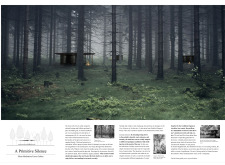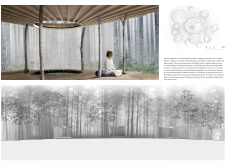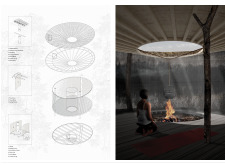5 key facts about this project
The project is located in the wooded area of Latvia, where it aims to foster a connection between nature and built structures. Designed as a series of pavilions, it serves as a retreat for individuals looking to find peace and rejuvenate their spirits. The design is grounded in cultural significance and simplicity, allowing users to engage in personal reflection and shared activities away from the pressures of everyday life.
Conceptual Framework
The design draws from Gottfried Semper's Four Elements of Architecture: hearth, roof, enclosure, and mound. These principles help address essential shelter requirements while offering flexibility in form. The arrangement of the pavilions enhances user experiences, promoting both personal introspection and communal gatherings.
Design and Spatial Organization
Each pavilion is crafted with a minimalist approach, allowing for an intimate relationship with the surrounding forest. The layout encourages exploration by inviting users to navigate the terrain, creating spaces for various interactions. The non-uniform placement of wooden columns provides each pavilion with a unique character, accommodating both solitary reflection and social opportunities.
Central Features
A key aspect of each pavilion is the central hearth, which acts as a focal point for diverse activities. It nurtures communal connections while still allowing for individual contemplation. The roofs and floors serve as horizontal lines that frame expansive views of the forest. The circular thatched roofs, with their slightly curved shapes, blend into the treetops and maintain the project’s overall visual harmony.
Materials and Construction
The design emphasizes locally sourced wood, showcasing a commitment to sustainability and honoring local craftsmanship. This choice connects the structures to their environment, reinforcing their cultural relevance. Light wells above the hearth bring in natural light, while surrounding fabric screens offer privacy and adaptability, underscoring the design's functional versatility.
The pavilions represent a thoughtful arrangement of space and structure. They allow users to engage deeply with their surroundings. Each detail, from the spacing of wooden columns to the selection of materials, contributes to an atmosphere tailored for reflection and connection.






















































